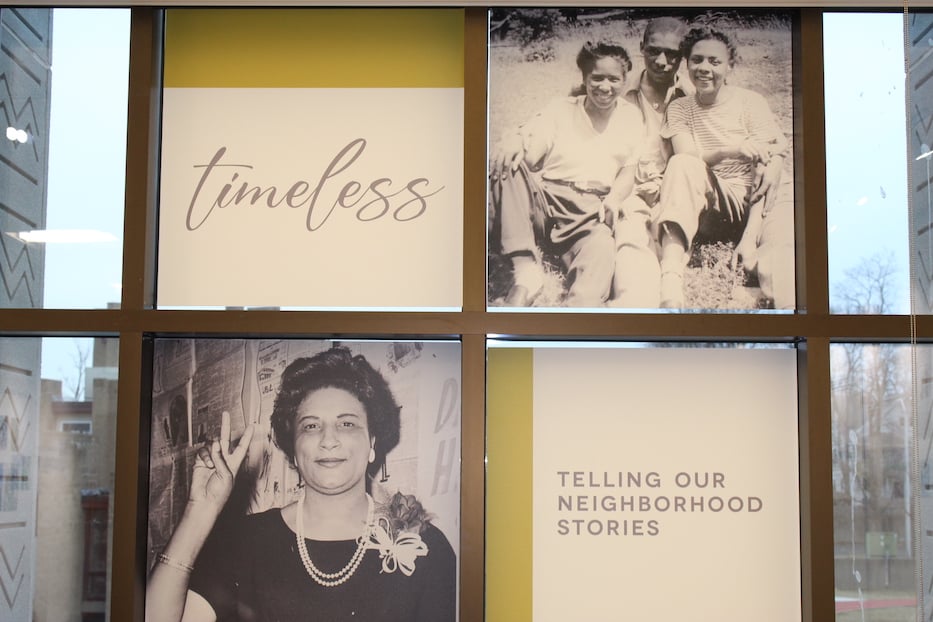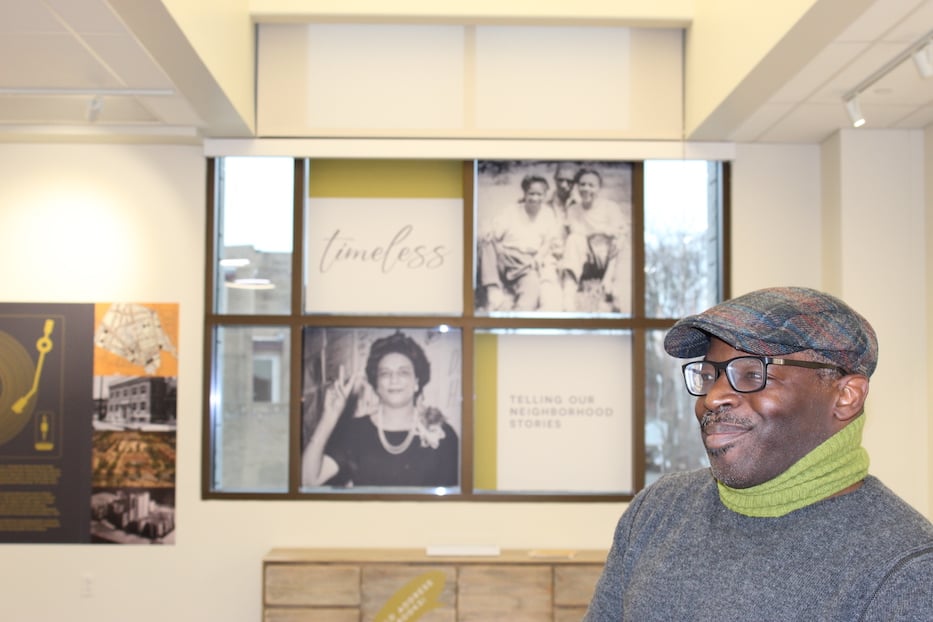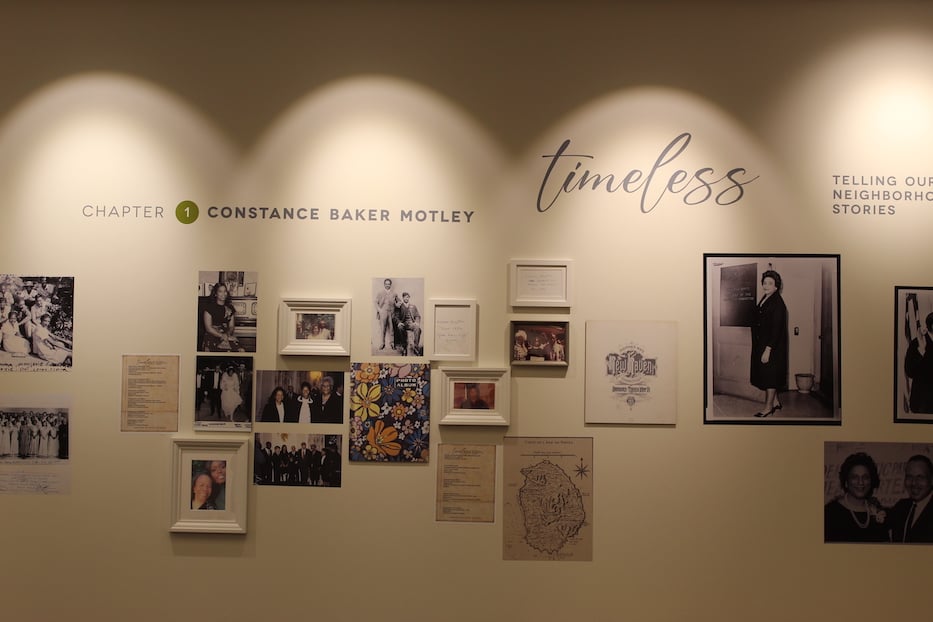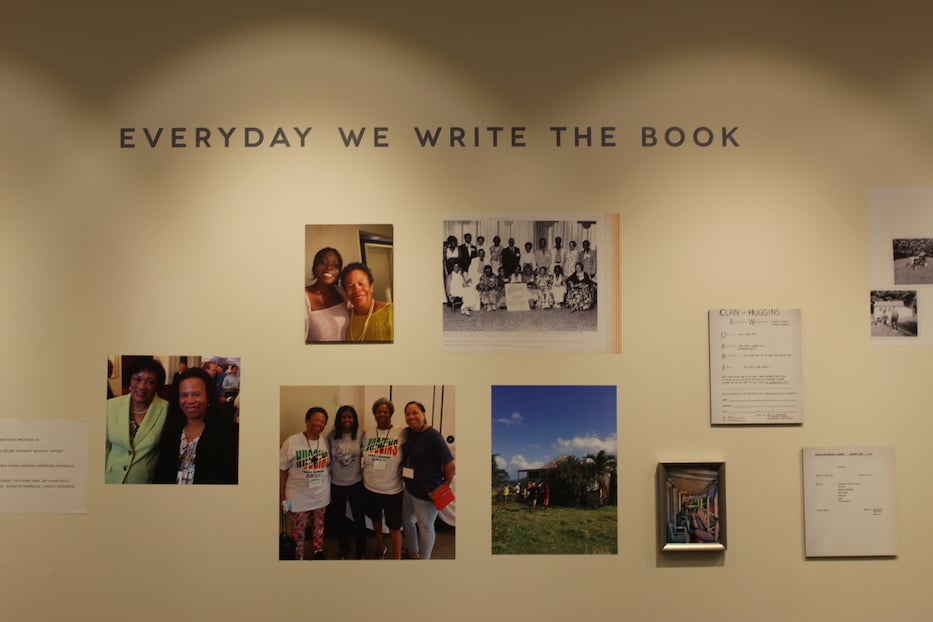
Marie Sanford Photos.
A large image of Judge Constance Baker Motley’s face greets visitors to the Toni and Wendell Harp Historical Museum at the Dixwell Community Q House. Beneath it, cursive script reads Timeless. A quick glance around the room reveals images of the late judge on her wedding day, promotional materials for the low-income housing Elm Haven, and images of a church choir—all scenes that begin to paint a picture of New Haven in the late 20th century.
It marks the opening of Telling Our Neighborhood Stories: Chapter One, a recognition of Motley’s life, work and history running at the Dixwell Community Q House through at least June. Funded by the Vineyard Project Founders Circle and the Black Futures Fund, the exhibition marks “Chapter One” of the Timeless exhibition series, dedicated to celebrating New Haven families and their stories.
Curated by W. Frank Mitchell and Constance (Connie) Royster, the latter of whom is Motley’s niece, the exhibit builds on an exhibition held last year at the Lillian Goldman Law Library at Yale University that highlighted Motley’s legal career. It will run through at least June of this year at the Toni and Wendell Harp Historical Museum, located on the second floor of the Q House.

Wm. Frank Mitchell in the exhibition. Marie Sanford Photos.
“[The exhibit] continues to tell the story of an important American figure born in New Haven, who was in effect discovered at the Q House,” Royster said in a recent email. “She is little known in many sectors ….I think the Q House exhibit built on the law school exhibit in important ways to tell a larger family and community story. It also encourages other families to create their own narratives.”
Constance Baker Motley was the sixth child of Willoughby Baker and Rachel Huggins, immigrants from the Caribbean Island of Nevis, and parish members at St. Luke’s Episcopal Church on Whalley Avenue. During her time at James Hillhouse High School, Motley served as president of the New Haven Negro Youth Council and secretary of the New Haven Adult Community Council. By the time she graduated from Hillhouse in 1939, she knew she wanted to practice law, but also could not afford the cost of higher education.
As the story goes, Motley was attending a program at the old Dixwell Avenue Q House when she was noticed by Clarence Blakeslee, a prominent white New Havener who agreed to pay for her undergraduate education, and ultimately her law school education. After graduating from Columbia Law School, Motley went on to work for the NAACP Legal Defense Fund before becoming a federal judge in New York. In doing so, she became the first Black woman on the federal bench.

The Q House exhibition, which opened earlier this month, is unique in that it features many materials given by Motley’s own family. In particular, Royster has been the main proprietor of most of the materials preserved by her mother, Eunice Royster. Methodically installed, Chapter One moves counterclockwise throughout the room, beginning with Motley’s early life and family origins, her time in law school, her career and influence over important jurisdictions. It closes with her family’s return to their land in Nevis and plans to restore their property there.
While Motley is the centerpiece of the exhibition, Mitchell, chief curator at the Harp museum, explained that the significance of the show is more on telling Motley’s family’s story. In fact, the opening reception functioned as a mini family reunion for the Baker family, which is still very connected in part due to Motley’s affluence and consequent ability to “convene and hold them together,” said Mitchell.
“There's that balance between what [Motley] achieves and other aspects of the family,” said Mitchell. “What we wanted to get from this and why Connie [Royster] is sort of a narrator and the witness to this is that I wanted her to be celebrating Constance Baker Motley, of course, but also her own parents and her siblings, and Uncle Moxie who she loved, and all other people who left a mark on New Haven.”
True to that vision, visitors can see old pictures of the siblings at summer camp or more recent documentation of Huggins family reunions. Those sit alongside images of Motley being celebrated in New York City or conferring with Martin Luther King, Jr. and Coretta Scott King.
Beyond the Baker family history, the exhibit—thanks to Eunice Royster’s diligence—also features glimpses of Black life from the 20th century that might otherwise be lost. For example, Royster kept many photos of Black church life and editions of The Connecticut Negro Bulletin. Through the Bulletin, viewers can see how Black residents of not only New Haven, but Connecticut as a whole stayed connected via the “Church, Business, and Fraternal Directory.”
As the Bulletin reads, “This will prove advantageous to all Negroes when visiting various Cities in State.”
“It's a good reminder of how small the state is,” said Mitchell. “Because the Black community felt so connected and there were fewer of them, people actively made an effort to spend Sunday an hour and a half away in Ansonia.”

For Mitchell, showing positive images of everyday Black life, particularly in the period from 1950-1980, is a way to counter the negative portrayals of the neighborhood increasingly propagated by the New Haven Register, the New York Times, the New Yorker, and similar publications beginning in the 1970s and 80s.
“In the 80s and in the 70s the Register wasn't covering dance contests and concerts and those things,” said Mitchell. “They were beginning to cover … this riot and that riot and the Panther trials.”
“Those things are super important and they've been well documented, but what we don't have is everyday life and what people were doing and how they were raising their kids so they can go off to college or get a great job in a factory down the street, or write a book or any of those kinds of things. So that's what we're hoping people will take from this.”
As the Timeless series continues, Mitchell aims to take elements of it to local schools and libraries where residents can learn how to digitally track down their family histories. In addition, he is conceptualizing family friendly workshops where young archivists can come to the Q House and make family scrapbooks or cookbooks. The consoles located in the middle of the gallery are already primed to hold these original archival materials.
In opening the series with materials that were literally lying around before Royster decided to do something with them, Mitchell hopes that other New Haveners feel empowered to share their own family histories and perhaps dig through those old boxes in their garages or basements.
“I also hope that a takeaway is a better understanding that the New Haven and Dixwell communities have an extraordinary history,” said Royster, “and that other families, like mine, also have stories to tell that are part of the fabric of New Haven.”
After all, there is not yet a Chapter Two.